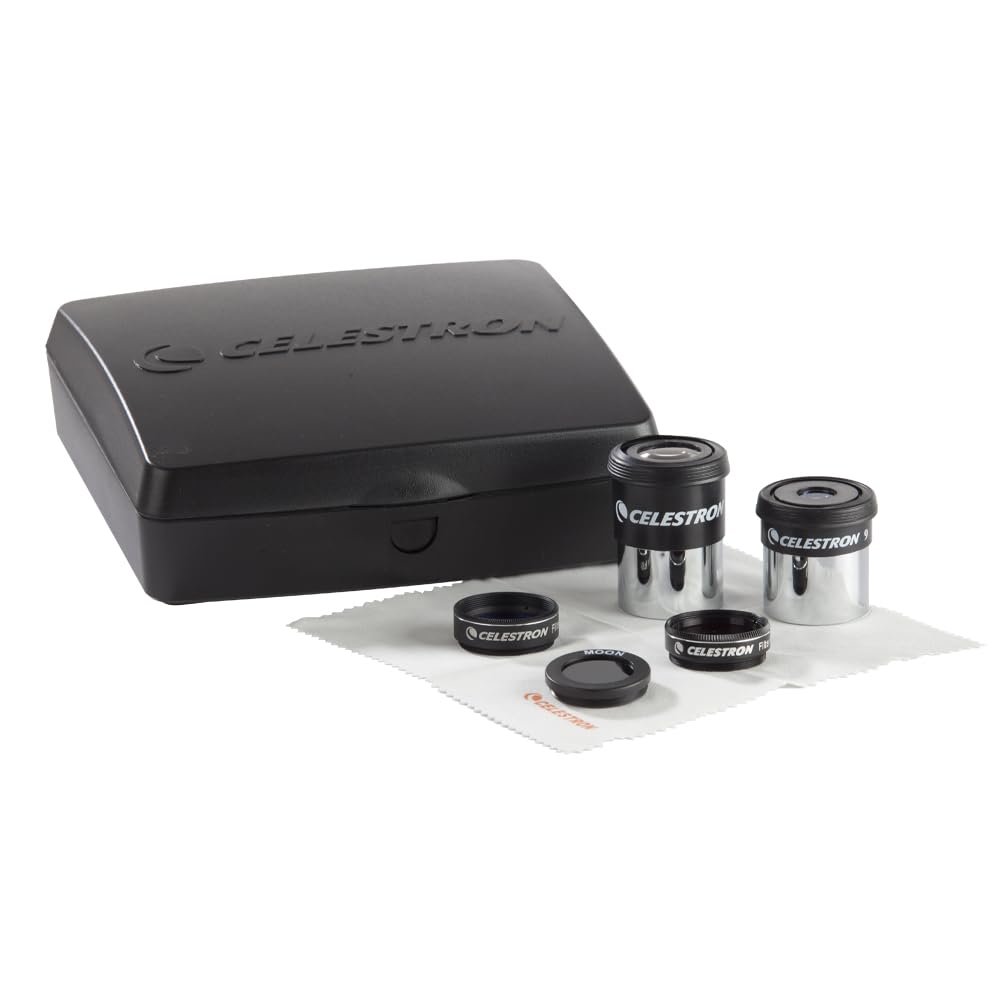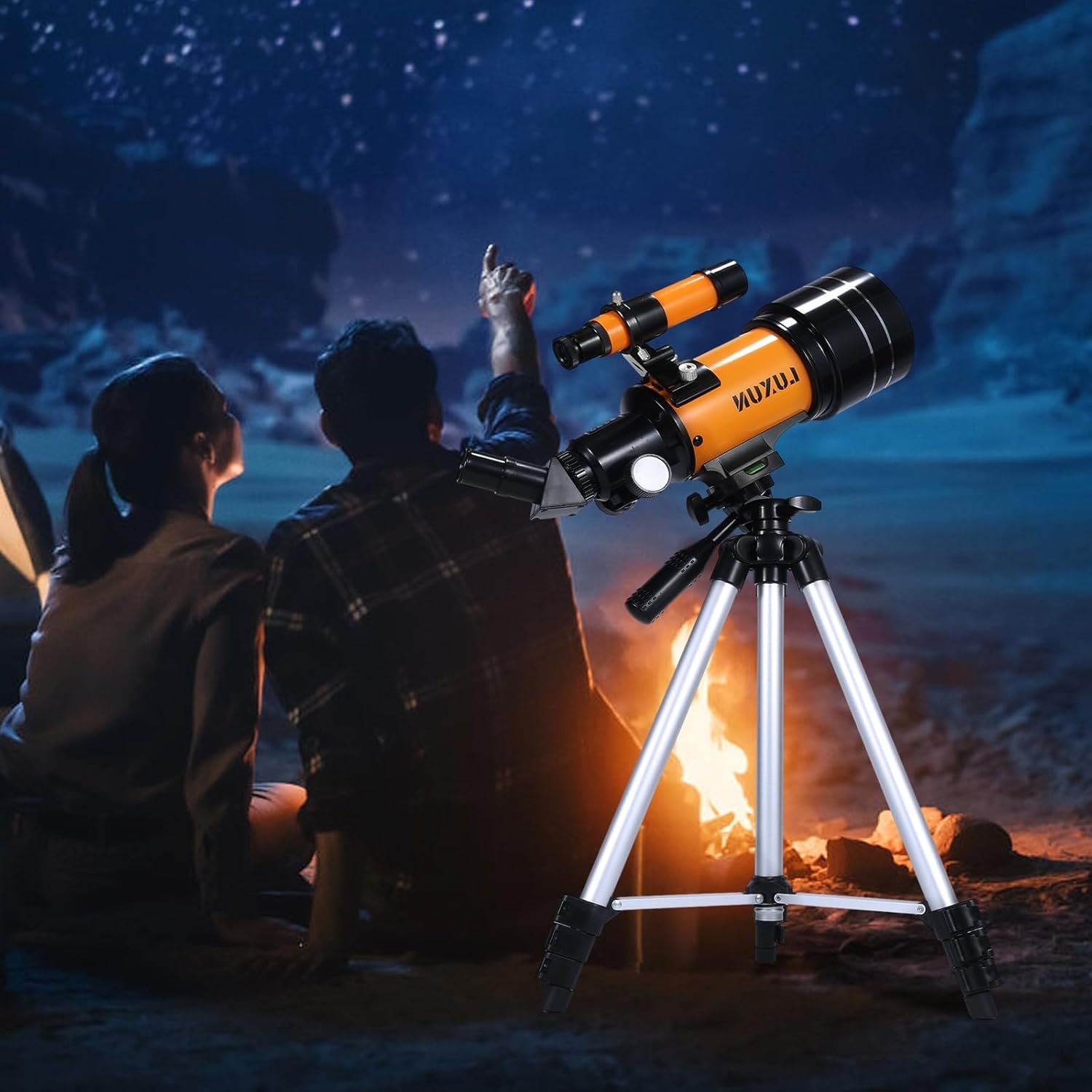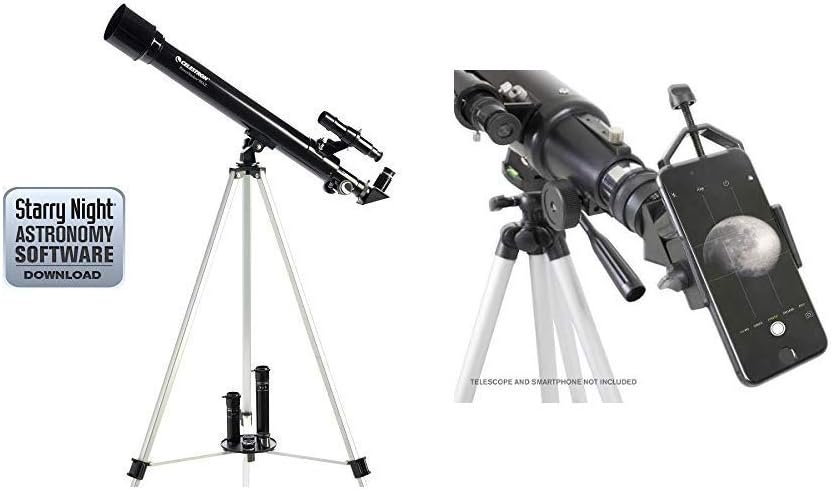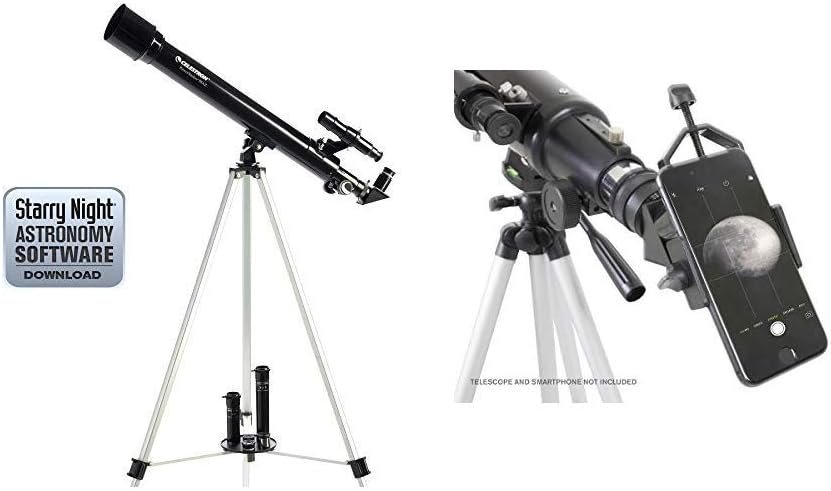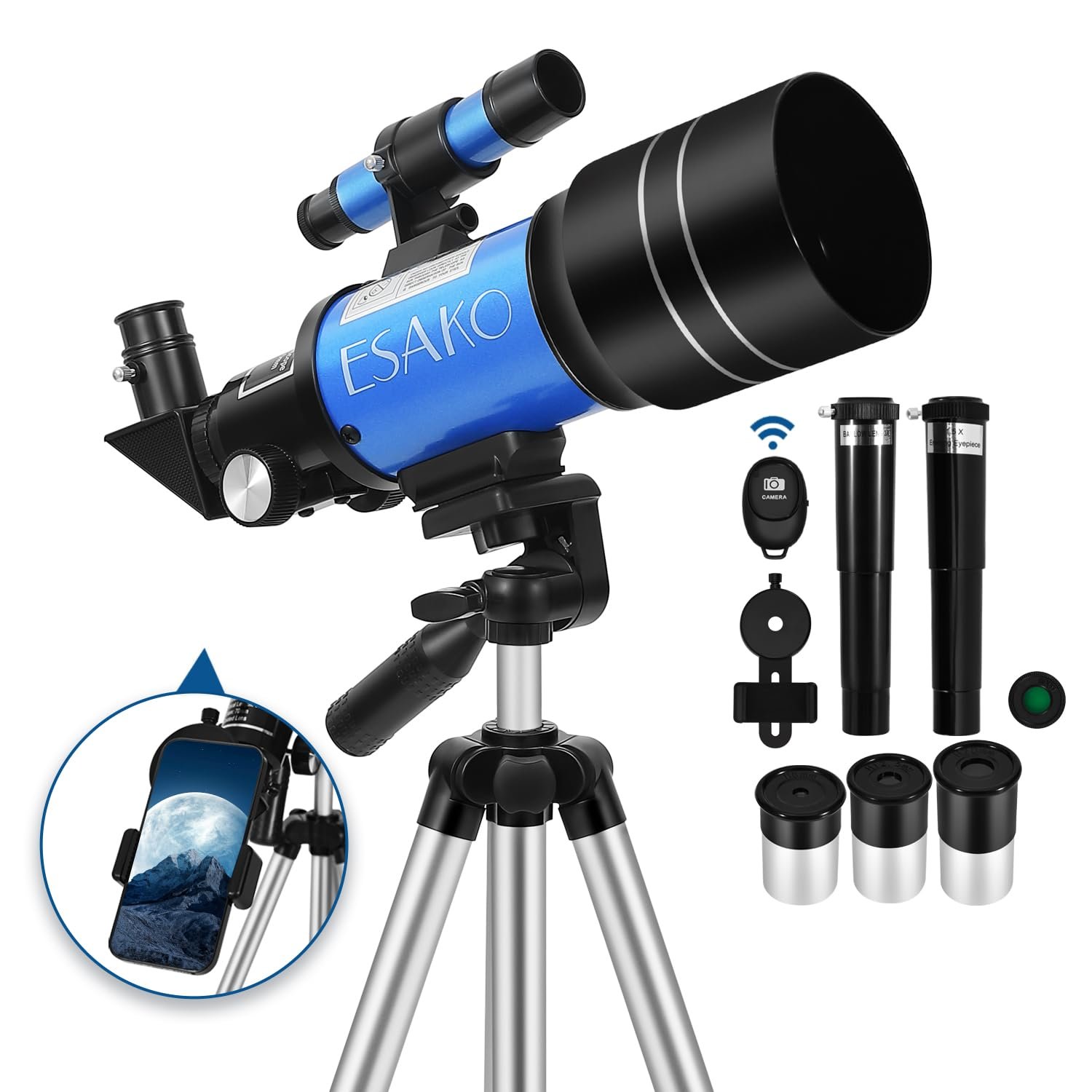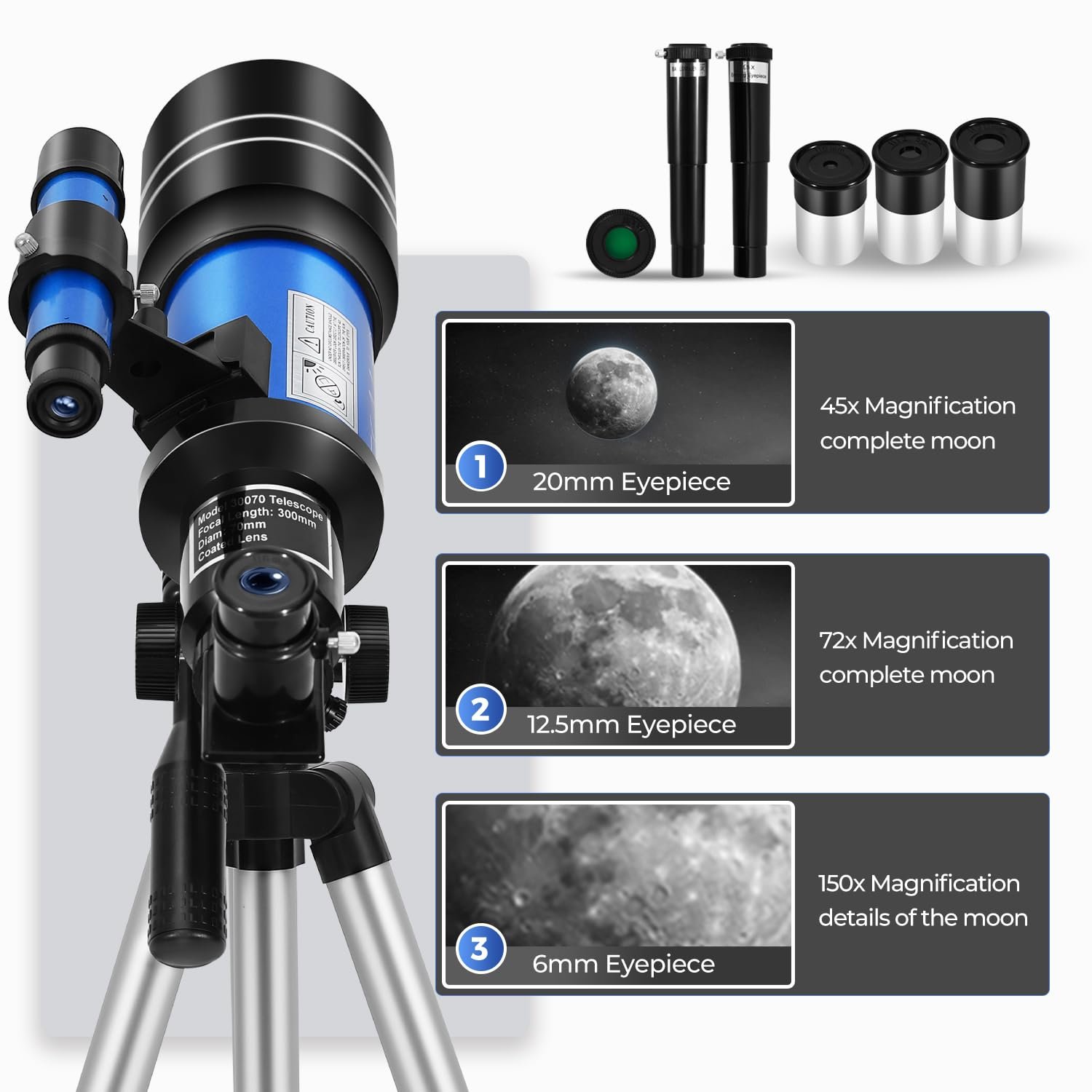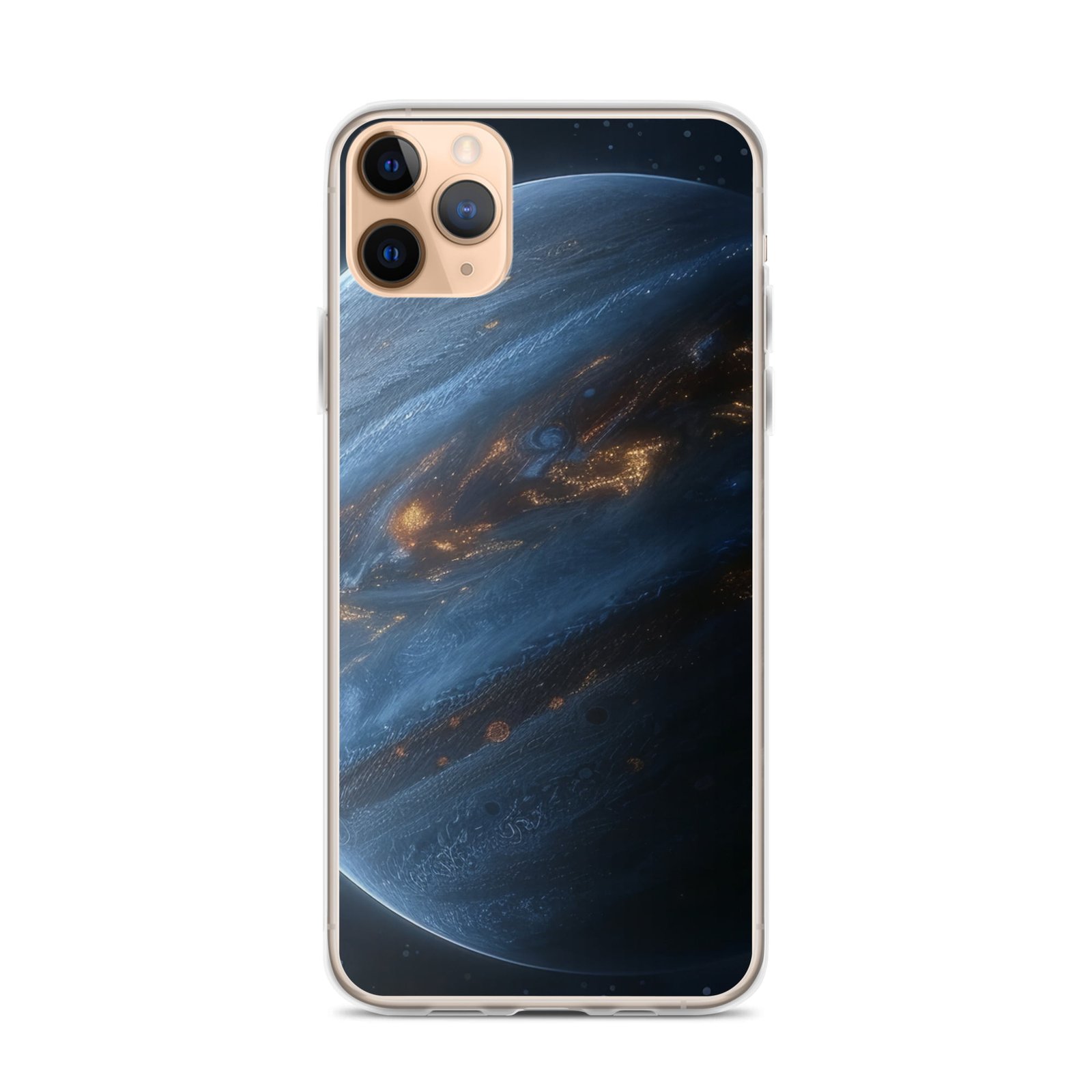
Takeaways 📝
- Captivating Insight: Observing galaxies allows amateur astronomers to connect with the universe, experiencing the thrill of viewing objects millions of light-years away.
- Surprising Statistic: There may be over two trillion galaxies in the observable universe, each with unique structures and histories.
- Provocative Perspective: The experience of observing galaxies transcends mere hobby; it fosters a deeper appreciation for our place in the cosmos.
- Real-world Application: Understanding different telescope types and their accessories can significantly enhance galaxy observation, making it accessible to beginners.
- Core Message: Astronomy is not just about equipment; it’s a journey of discovery that connects individuals with the vastness and beauty of the universe
Celestron 94306 PowerSeeker Telescope Accessory Kit – 2X 1.25 Kellner Eyepieces
MLABINYA 70mm Travel Astronomical Refracting Telescope with Multilayer Broadband Coating
BrandName Telescope for Adults Astronomy 70mm Aperture 400mm Focal Length
Celestron PowerSeeker 50 AZ Refractor Telescope with Basic Smartphone Adapter
ESAKO Telescope for Kids & Beginners, 70mm Aperture
Sky-Watcher Esprit 100mm ED Triplet APO Refractor Telescope
Galaxies and Telescopes
Galaxies are vast systems that consist of stars, stellar remnants, interstellar gas and dust, as well as dark matter, all bound together by gravity. They play a pivotal role in the cosmos and come in various shapes and sizes, primarily classified into three main types: spiral, elliptical, and irregular galaxies. A notable example is the Milky Way, our home galaxy, which is a barred spiral galaxy containing billions of stars, along with planets, moons, and a myriad of other celestial objects. Observations suggest that there may well be over two trillion galaxies in the observable universe, each presenting a unique structure and evolutionary history, making them a fascinating subject for both professional and amateur astronomers alike.
The exploration of galaxies has been greatly enhanced by the advent of telescopes. These instruments have transformed our understanding of the universe, enabling astronomers to observe celestial objects that are millions or even billions of light-years away. Telescopes function by capturing and magnifying light, allowing users to examine distant galaxies in greater detail. They range from simple optical devices to sophisticated instruments equipped with advanced technology, such as electronic sensors and adaptive optics. Amateur astronomers can take advantage of various telescope types, from refractors to reflectors, to observe galaxies, nebulae, and star clusters in the night sky.
Investing in a telescope opens a door to the wonders of the universe, enabling individuals to glimpse the intricacies of far-off galaxies. Such an experience cultivates a deeper appreciation for the vastness of space and our place within it. The macrocosm of the cosmos stands not only as a subject of professional academic study but also as an avenue for hobbyists, who can now participate in the ongoing journey of astronomical discovery. As technology improves, amateur astronomers are increasingly able to contribute to our collective understanding of these celestial giants.
Why Observing Galaxies is a Rewarding Experience

For amateur astronomers, the pursuit of knowledge about celestial bodies often leads to an encounter with galaxies, which are among the most magnificent and diverse structures in the universe. Observing galaxies is not only an exhilarating experience but also an opportunity to connect with the cosmos on a profound level. The thrill of viewing objects that are millions or even billions of light-years away evokes a sense of wonder and curiosity that few other pursuits can match. Each galaxy serves as a reminder of the vastness of space and the time it takes for light from these distant wonders to reach Earth.
One of the most compelling reasons to observe galaxies lies in their diversity. Galaxies come in various shapes and sizes, including spiral, elliptical, and irregular forms, each showcasing unique features that contribute to their beauty. For instance, the iconic spiral arms of galaxies like the Milky Way and Andromeda are often depicted in images that captivate both novice and seasoned stargazers alike. These structural variations provide a rich field of study for amateur astronomers, encouraging exploration beyond our home galaxy. Every observation presents an opportunity to learn more about the formation and evolution of these cosmic entities.
Moreover, observing galaxies enhances an individual’s appreciation for the universe. The breathtaking visuals of galaxies, often differentiated by their colors and structures, evoke a sense of awe. As astronomers capture images of distant galaxies through telescopes, they witness relics of the universe’s history. This interaction fosters a deeper understanding of the dynamics of cosmic evolution. Engaging with galaxies enables amateur astronomers to appreciate not only their stunning aesthetics but also the scientific stories they represent. Ultimately, the experience of observing galaxies is enriching; it draws enthusiasts into a universe filled with beauty, diversity, and an endless quest for knowledge.
Types of Telescopes for Galaxy Observation
When embarking on the journey of galaxy observation, the first critical decision is selecting the appropriate telescope. The three primary types of telescopes available to amateur astronomers are refractors, reflectors, and compound telescopes, each having distinct advantages and disadvantages that can influence the experience of stargazing.
Refractor telescopes utilize lenses to bend light, producing sharp and clear images. One of their key benefits is their minimal maintenance requirements, as the lenses do not require frequent collimation. This makes refractors an excellent choice for beginners who may not wish to deal with the complexities of optical alignment. However, they often come with a higher price tag for larger apertures, which can limit their accessibility for amateur astronomers on a budget.
On the other hand, reflector telescopes employ mirrors to gather and focus light. This design allows for larger apertures at more affordable prices, making reflectors highly popular among novice astronomers seeking to observe faint galaxies. While they provide excellent light-gathering capabilities, they necessitate regular collimation to maintain optimal performance. Additionally, the open design of many reflectors can be susceptible to dust accumulation, requiring occasional cleaning.
Compound telescopes combine features from both refractors and reflectors. They typically utilize a combination of lenses and mirrors, offering a compact design and versatile optical performance. These telescopes are often favored for their portability and user-friendliness. Nevertheless, they can also carry a higher cost. For beginners who may find the decision overwhelming, a compound telescope is a well-rounded option that offers the benefits of both systems in a single instrument.
In conclusion, the type of telescope best suited for galaxy observation will ultimately depend on the individual’s preferences, budget, and willingness to engage in maintenance. Understanding the differences between refractors, reflectors, and compound telescopes is essential for novice astronomers to select an instrument that enhances their galaxy-viewing experiences.
Essential Equipment and Accessories

For amateur astronomers aiming to observe galaxies, selecting the right equipment goes beyond just acquiring a good telescope. A range of accessories can significantly enhance the overall stargazing experience. One of the most vital components is the selection of eyepieces. Different eyepieces offer varying magnifications and fields of view, allowing astronomers to adapt their observations based on the size and distance of the galaxies they are viewing. For example, a low-power eyepiece may be ideal for capturing expansive views of a galaxy, while a high-power eyepiece could facilitate a closer inspection of specific features.
Star charts are another indispensable tool for galaxy observation. These charts serve as maps of the night sky, helping observers identify constellations and locate specific galaxies. Today, many amateur astronomers utilize mobile applications that provide interactive sky maps tailored to their geographical location and current time. This digital approach not only simplifies the navigation of the skies but also offers real-time updates on celestial events that may affect visibility, such as the presence of the moon or atmospheric conditions.
Additionally, filters can enhance visibility when observing galaxies. A UHC (Ultra High Contrast) filter can help reveal more details by reducing the glare from light pollution and increasing contrast. Such filters are especially beneficial when viewing faint objects, making them appear more vivid against the background of the night sky. It is important to choose the right filter according to the specific galaxy and observing conditions, as different filters may yield varying levels of clarity.
Using these accessories effectively can lead to a more rewarding observation experience. By incorporating high-quality eyepieces, utilizing star charts, and applying suitable filters, amateur astronomers can significantly improve their ability to view and appreciate the wonders of the cosmos. With the right equipment, the intricate details of galaxies become more accessible, enriching the journey into deep space. Understanding how to utilize these tools not only enhances observation but also deepens one’s connection to the intriguing universe.
Best Galaxies to Observe for Beginners
For amateur astronomers, exploring the night sky can be an exhilarating experience, particularly when it comes to observing galaxies. Certain galaxies are not only spectacular in their beauty but are also relatively easy to locate with basic astronomical equipment. Here are some of the best galaxies to observe for beginners.
The Andromeda Galaxy (M31) is perhaps the most renowned target for novice stargazers. Located approximately 2.537 million light-years from Earth, it is the nearest spiral galaxy to our own Milky Way. Visible to the naked eye under dark skies, its brightest core can be found shining with a faint glow. To locate Andromeda, find the constellation Andromeda, which can be identified from the prominent squares formed by stars in the Pegasus constellation.
The Triangulum Galaxy (M33) is another excellent choice for beginners, thanks to its relative brightness and size. This spiral galaxy is part of the Local Group, which includes the Andromeda Galaxy. Triangulum can be found adjacent to Andromeda and is visible with small telescopes or binoculars, especially from rural areas where light pollution is minimized. Look for the constellation Triangulum, which will guide you to this magnificent galaxy.
The Whirlpool Galaxy (M51) offers a stunning view of a classic spiral structure, making it an intriguing option for novice astronomers. Best observed with a small telescope, M51 can be found in the constellation Canes Venatici. Its distinctive spiral arms and interactions with a nearby dwarf galaxy enhance its aesthetic appeal, giving beginners an excellent target to observe.
Lastly, the Pinwheel Galaxy (M101) is another spiral galaxy worth observing. Situated in the constellation Ursa Major, it is best viewed through telescopes during the spring and early summer months. The Pinwheel’s intricate structure and brightness make it easy for beginners to spot it amidst the stars.
These galaxies provide a wonderful starting point for amateur astronomers looking to explore deep space. Each offers unique features and visibility conditions tailored for those just beginning their astronomical journey.
Understanding the Sky: Tips for Stargazing

Amateur astronomers looking to observe galaxies must start with proper preparation and understanding of their environment. One of the first and most critical steps in facilitating a successful stargazing experience is to find a location that offers minimal light pollution. Urban areas typically suffer from significant interference, so it is advisable to seek out dark sky locations, such as national parks or rural settings. Utilizing light pollution maps can help identify optimal stargazing sites where the celestial bodies can be seen more clearly.
Timing is equally crucial for galaxy observation. Typically, the best times for stargazing are during the new moon phase when the moon’s light does not outshine fainter celestial objects. Moreover, observing during colder months can also yield better visibility since the atmosphere tends to be clearer. To ensure visibility of particular galaxies, consulting astronomical calendars can prove beneficial. Events such as meteor showers or conjunctions can add to the experience, providing additional points of interest to observe.
Once in a suitable location during the right time, being able to read star maps will greatly enhance the stargazing experience. These maps serve as a roadmap to the night sky, allowing amateur astronomers to identify constellations and pinpoint the locations of various galaxies. Familiarizing oneself with prominent constellations can provide a foundation for navigating the sky. There are several mobile applications and resources available that can assist in translating the complex layout of celestial bodies into user-friendly guides, making the task of locating galaxies much more accessible.
By following these practical tips, amateur astronomers can significantly improve their chances of successfully observing galaxies and enjoying the beauty of the night sky. Preparation, timing, and navigation are key elements that contribute to a rewarding stargazing experience.
Common Challenges and How to Overcome Them
Astronomy can be a rewarding hobby, but amateur astronomers often face several challenges when attempting to observe galaxies. One of the most significant obstacles is light pollution, which can obscure faint celestial objects. Urban areas, in particular, are notorious for high levels of artificial light that interfere with stargazing. To mitigate light pollution, it is advisable to seek locations that are away from city lights, ideally in designated dark sky parks or rural areas. Additionally, using light pollution filters on telescopes can enhance visibility by reducing the impact of unwanted light.
Another factor that can hinder galaxy observation is atmospheric conditions. The clarity of the night sky is influenced by weather patterns, humidity, and temperature fluctuations. Poor atmospheric seeing can lead to distorted images and a less enjoyable experience. To counteract this, amateur astronomers should regularly check weather forecasts and strive to observe on nights when the atmosphere is stable. Late-night hours, often after sunset, tend to yield better atmospheric conditions for viewing celestial bodies.
Moreover, the setup and calibration of telescopes can pose challenges for beginners. An improperly aligned telescope can significantly diminish the quality of the observation experience. It is crucial for amateur astronomers to familiarize themselves with their equipment and follow best practices for setup. Spending time on proper alignment and ensuring the telescope is balanced can greatly enhance the clarity and stability of views. Utilizing star charts and smartphone apps can assist in locating celestial targets and adjusting settings appropriately.
By being aware of these common challenges and actively seeking solutions, amateur astronomers can greatly improve their observing experiences. The joy of seeing galaxies and other astronomical wonders can be achieved through preparation and perseverance.
Documenting Your Galaxy Observations
For amateur astronomers, documenting galaxy observations is a crucial practice that enhances understanding and appreciation of the cosmos. By maintaining a detailed log, one can track observations over time, develop skills, and contribute to the citizen science community. Effective documentation methods include taking notes, creating sketches, and engaging in astrophotography.
Taking notes during observations allows astronomers to record essential details, such as the date, time, location, and specific conditions of the night sky. Additionally, including information about the galaxies observed, their distinguishing features, and any notable phenomena can significantly enrich the observation log. This practice also helps in identifying patterns and changes over time. Utilizing a simple notebook or a dedicated app designed for astronomical observations can facilitate this process.
Sketching is another valuable technique to capture galaxy observations. This method not only improves your artistic skills but also sharpens the ability to recognize key characteristics of the galaxies being observed. By focusing on visual details, such as shape, brightness, and position relative to nearby stars, amateur astronomers can create personal records that reflect both their artistic interpretation and observational insights. Ensuring that sketches are dated and labeled with relevant information can enhance their utility for future reference.
Astrophotography offers a modern and compelling way to document galaxy observations. With advancements in camera technology, even entry-level devices can produce impressive images of celestial objects. Utilizing appropriate settings, such as exposure time and ISO, along with post-processing techniques, can significantly enhance the final outcome. This method not only preserves the experience but also allows for sharing stunning images with the astronomical community and the public, thereby fostering greater interest in the night sky.
Embrace the Journey of Galaxy Observation

As we conclude this guide on observing galaxies, it is essential to highlight the unique journey that amateur astronomers embark upon when they turn their telescopes to the night sky. The cosmos offers an endless array of wonders, and the quest to discover these magnificent celestial bodies requires both enthusiasm and patience. Each time you set out to observe, whether in your backyard or at a designated observation site, you are engaging with the vastness of the universe that surrounds us.
Amateur astronomy is not merely about the equipment or the technical skills; it is about fostering a profound connection with the universe. Every galaxy you observe provides a glimpse of billions of stars and gives insight into the origins of the universe itself. Armed with a telescope and a curious mindset, the experience of discovering galaxies serves as a conduit to understanding our place in this vast expanse. As you develop your skills in identifying various celestial formations, the joy and satisfaction that come from each successful observation will be immeasurable.
Moreover, this journey is not merely solitary. Engaging with local astronomy clubs, joining online forums, and participating in star parties can immensely enhance your experience. Sharing discoveries, learning from others, and enjoying the collective awe of the night sky foster a strong sense of community among fellow enthusiasts. Thus, as you venture into the world of galaxy observation, remember to embrace both the challenges and the triumphs. The beauty of the universe is waiting to be unveiled, and every observation contributes to the stories we tell about the cosmos. Happy stargazing!


